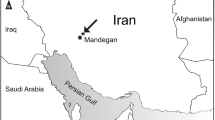Abstract
A chlorococcal alga of the genus Coelastrum is firstly described from the sediments of the Eocene Lake Messel on the basis of morphological characters and fluorescence microscopy. The great abundance of this alga in massive parts of the stratigraphic section shows its significance for the Messel ecosystem in Eocene times, besides other known algae from this locality. The very favourable conditions of fossilisation allow the identification of various generational stages of this alga. Interestingly, the best preserved specimens were found in small fish coprolites (although we interpret Coelastrum sp. as by-catch and not an important source of food for fish).






























Similar content being viewed by others
References
Bradley WH (1929) Freshwater algae from the Greenriver Formation of Colorado. Bull Torrey Bot Club 56:421–428
Bradley WH (1931) Origin and microfossils of the oil shale of the Green River formation of Colorado and Utah. U.S. Geological Survey Professional Paper 168
Clausing A (1998) Mikro-organofazielle Studien an Sedimenten desEnspel-Sees (Oberoligozän, Westerwald, Deutschland). Hallesches JbGeowiss B 20:119–133
Clausing A (2000) Limnische Primärproduktion im deutschen Tertiär: Kenntnisstand und Perspektiven. Zbl Geol Paläont Teil II:1–13
Dangeard P-A (1889) Mémoire sur les algues. Le Botaniste 1:127–174
Felder M, Gaupp R (2006) The δ13C and δ18 O signatures of siderite—a tool to discriminate mixis patterns in ancient lakes. Z dt Ges Geowiss 157(3):387–410
Felder M, Harms F-J (2004) Lithologie und genetische Interpretation der vulkano-sedimentären Ablagerungen aus der Grube Messel anhand der Forschungsbohrung Messel 2001 und weiterer Bohrungen. Cour Forsch-Inst Senckenberg 252:151–203
Friedrich WL, Schaarschmidt F (1977) Zwei- und dreidimensionale Fluoreszenzaufnahmen von fossilen Pflanzen. Cour Forsch-Inst Senckenberg 24:31–49
Goth K (1990) Der Messeler Ölschiefer – ein Algenlaminit. Cour Forsch-Inst Senckenberg 131:1–143
Gray J (1960) Fossil Chlorophycean Algae from the Miocene of Oregon. J Palaeontol 34:453–463
Hegewald E, Wolf M, Keller A, Friedl T, Krienitz L (2010) ITS2 sequence structure phylogeny in the Scenedesmaceae with special reference to Coelastrum (Chlorophyta, Chlorophycea). Phycologia 49(4):325–335
Heil R (1964) Kieselschwammnadeln im Ölschiefer der Grube Messel bei Darmstadt. Notizbl hess L-Amt Bodenforsch 92:60–67
Jankovská V, Komárek J (2000) Indicative value of Pediastrum and other Coccal Green Algae in Palaeoecology. Folia Geobotanica 35:59–82
Komárek J, Fott B (1983) Chlorophyceae, Ordnung Chlorococcales. In: Huber-Pestalozzi G (ed) Das Phytoplankton des Süßwassers, Die Binnengewässer 16, 7/1, Stuttgart
Liebig K (1998) Fossil microoganisms from the Eocene Oil-shale of Southern Hesse, Germany. Kaupia - Darmstädter Beitr Naturgesch 7:1–95
Martini E, Rietschel S (1978) Lösungserscheinungen an Schwammnadeln im Messeler Ölschiefer (Mittel-Eozän). Erdoel Erdgas 94(3):89–104
Matthes G (1966) Zur Geologie des Ölschiefervorkommens von Messel bei Darmstadt. Abh hess L-Amt Bodenforsch 51:1–87
Michaelis W, Jenisch A, Richnow HH, Kruse U, Mycke B (1988) Organofazies des Ölschiefers von Messel. Cour Forsch-Inst Senckenberg 107:89–103
Müller WEG, Zahn RK, Maidhoff A (1982) Spongilla gutenbergiana n.sp., ein Süßwasserschwamm aus dem Mittel-Eozän von Messel. Senck leth 63(5/6):465–472
Nägeli C (1849) Gattungen einzelliger Algen. Zürich
Petschick R (2002) Röntgendiffraktometrie in der Sedimentologie (K5). In: Hüssner H, Hinderer M, Götz AE, Petschick, R (ed.) Sediment. Schriftenr Dtsch Geol Ges 18:99–118
Printz H (1927) Chlorophyceae. In: Engler A (ed) Die natürlichen Pflanzenfamilien, 3. Band, 2nd edn. Leipzig
Richter G, Baszio S (2000) Zur Taphonomie von Spongilliden (Porifera)—1. Korrosionserscheinungen an fossilen Skleren der Grube Messel. Senck leth 80(2):445–461
Richter G, Baszio S (2001) Traces of a limnic food web in the Eocene Lake Messel. Palaeogeogr Palaeoclimatol Palaeoecol 166(3/4):343–368
Richter G, Baszio S (2002) Beiträge zur Ökologie des tertiären Messelsees. Natur und Museum 132:137–149
Richter G, Clausing A (2004) Süßwasser-Dinoflagellaten aus der Grube Messel. Natur und Museum 134(4):129–130
Richter G, Wedmann S (2005) Ecology of the Eocene Lake Messel, revealed by analysis of small fish coprolites and sediments from a drilling core. Palaeogeogr Palaeoclimatol Palaeoecol 223:147–161
Schaal S, Möller M (1991) Methodik der Senckenberg-Grabungen 1988–1990 und Ergebnisse zur Taphozönose der Messelformation. Cour Forsch-Inst Senckenberg 139:127–145
Schulz R, Harms F-J, Felder M (2002) Die Forschungsbohrung Messel 2001: Ein Beitrag zur Entschlüsselung der Genese einer Ölschieferlagerstätte. Z Angew Geol 4:9–17
Zippi PA (1998) Freshwater algae from the Mattagami formation (Albian), Ontario: Palaeoecology, botanical affinities, and systematic taxonomy. Micropalaeontology 44(supplement 1):1–78
Acknowledgements
Our hearty thanks for their valuable help in the form of advice concerning improvements, corrections and completion of our work as well as for the technical preparation of the material go to numerous colleagues of which we can only name a few: Dr. Regina Albert, Frankfurt, Dr. Andreas Clausing, Halle (Saale), Dr. Vlasta Jankovská, Institute of Botany AS CR, Department of Vegetation Ecology, Brno Czech Republic, Prof. Dr. Jiri Komárek, Institute of Botany AS CR, Centrum for Algology, Trebon, Czech Republic, Dr. Maike Lorenz, collection of algae cultures (SAG), University Göttingen, Dr. Dieter Mollenhauer, Senckenberg Research Institute, Frankfurt/Main, Germany, Dr. Rainer Petschick, Goethe-University Frankfurt/Main, Germany, Marie-Louise Tritz, Senckenberg Research Institute Frankfurt/Main Germany, Dr. Stefan Schaal, Dr. Sonja Wedmann, Michael Ackermann, Bruno Behr, Senckenberg Research Institute, Frankfurt/Main, and the Excavation Team from Hessisches Landesmuseum Darmstadt for their help, patience and understanding in providing and completing the fossil samples. We are very grateful to the reviewers, Dr. Vlasta Jankovská, Institute of Botany AS CR, Brno, Czech Republic, and Dr. Eberhard Hegewald, Forschungszentrum Jülich GmbH, Institut für Bio- und Geowissenschaften, Pflanzenwissenschaften, for their very valuable comments on an earlier version of this manuscript.
Author information
Authors and Affiliations
Corresponding author
Rights and permissions
About this article
Cite this article
Richter, G., Schiller, W. & Baszio, S. A green alga of the genus Coelastrum Naegeli from the sediments of the Tertiary Lake Messel. Palaeobio Palaeoenv 93, 285–298 (2013). https://doi.org/10.1007/s12549-012-0105-5
Received:
Revised:
Accepted:
Published:
Issue Date:
DOI: https://doi.org/10.1007/s12549-012-0105-5




